
In music theory, counterpoint is the relationship of two or more simultaneous musical lines that are harmonically interdependent yet independent in rhythm and melodic contour. The term originates from the Latin punctus contra punctum meaning "point against point", i.e. "note against note". John Rahn describes counterpoint as follows:
It is hard to write a beautiful song. It is harder to write several individually beautiful songs that, when sung simultaneously, sound as a more beautiful polyphonic whole. The internal structures that create each of the voices separately must contribute to the emergent structure of the polyphony, which in turn must reinforce and comment on the structures of the individual voices. The way that is accomplished in detail is ... 'counterpoint'.

Henry Dixon Cowell was an American composer, writer, pianist, publisher, teacher and the husband of Sidney Robertson Cowell. Earning a reputation as an extremely controversial performer and eccentric composer, Cowell became a leading figure of American avant-garde music for the first half of the 20th century — his writings and music serving as a great influence to similar artists at the time, including Lou Harrison, George Antheil, and John Cage, among others. He is considered one of America's most important and influential composers.
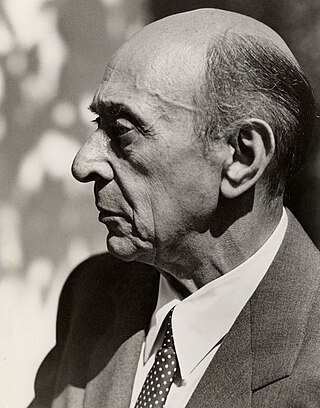
The twelve-tone technique—also known as dodecaphony, twelve-tone serialism, and twelve-note composition—is a method of musical composition. The technique is a means of ensuring that all 12 notes of the chromatic scale are sounded equally often in a piece of music while preventing the emphasis of any one note through the use of tone rows, orderings of the 12 pitch classes. All 12 notes are thus given more or less equal importance, and the music avoids being in a key.

Lou Silver Harrison was an American composer, music critic, music theorist, painter, and creator of unique musical instruments. Harrison initially wrote in a dissonant, ultramodernist style similar to his former teacher and contemporary, Henry Cowell, but later moved toward incorporating elements of non-Western cultures into his work. Notable examples include a number of pieces written for Javanese style gamelan instruments, inspired after studying with noted gamelan musician Kanjeng Notoprojo in Indonesia. Harrison would create his own musical ensembles and instruments with his partner, William Colvig, who are now both considered founders of the American gamelan movement and world music; along with composers Harry Partch and Claude Vivier, and ethnomusicologist Colin McPhee.
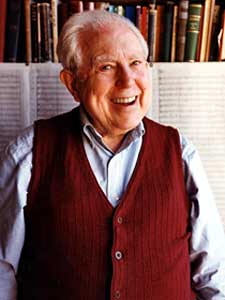
Elliott Cook Carter Jr. was an American modernist composer who was one of the most respected composers of the second half of the 20th century. He combined elements of European modernism and American "ultra-modernism" into a distinctive style with a personal harmonic and rhythmic language, after an early neoclassical phase. His compositions are performed throughout the world, and include orchestral, chamber music, solo instrumental, and vocal works. Carter was the recipient of many awards – he was twice awarded the Pulitzer Prize for his string quartets. He also wrote the large-scale orchestral triptych Symphonia: sum fluxae pretium spei.

Henry Dreyfuss Brant was a Canadian-born American composer. An expert orchestrator with a flair for experimentation, many of Brant's works featured spatialization techniques.
A tone cluster is a musical chord comprising at least three adjacent tones in a scale. Prototypical tone clusters are based on the chromatic scale and are separated by semitones. For instance, three adjacent piano keys struck simultaneously produce a tone cluster. Variants of the tone cluster include chords comprising adjacent tones separated diatonically, pentatonically, or microtonally. On the piano, such clusters often involve the simultaneous striking of neighboring white or black keys.

Witold Roman Lutosławski was a Polish composer and conductor. Among the major composers of 20th-century classical music, he is "generally regarded as the most significant Polish composer since Szymanowski, and possibly the greatest Polish composer since Chopin". His compositions—of which he was a notable conductor—include representatives of most traditional genres, aside from opera: symphonies, concertos, orchestral song cycles, other orchestral works, and chamber works. Among his best known works are his four symphonies, the Variations on a Theme by Paganini (1941), the Concerto for Orchestra (1954), and his cello concerto (1970).

Roger Huntington Sessions was an American composer, teacher, and writer on music. He had initially started his career writing in a neoclassical style, but gradually moved further towards more complex harmonies and postromanticism, and finally the twelve-tone serialism of the Second Viennese School. Sessions' friendship with Arnold Schoenberg influenced this, but he would modify the technique to develop a unique style involving rows to supply melodic thematic material, while composing the subsidiary parts in a free and dissonant manner.

Pyotr Ilyich Tchaikovsky's Symphony No. 4 in F minor, Op. 36, was written between 1877 and 1878. Its first performance was at a Russian Musical Society concert in Moscow on February 22, 1878, with Nikolai Rubinstein as conductor. In Central Europe it sometimes receives the nickname "Fatum", or "Fate".
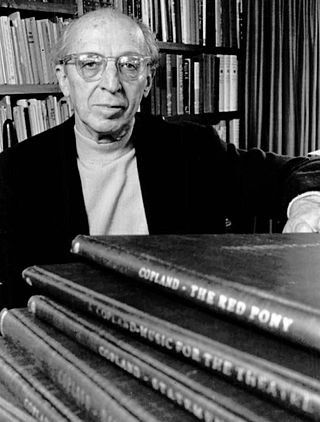
Connotations is a classical music composition for symphony orchestra written by American composer Aaron Copland. Commissioned by Leonard Bernstein in 1962 to commemorate the opening of Philharmonic Hall in New York City, United States, this piece marks a departure from Copland's populist period, which began with El Salón México in 1936 and includes the works he is most famous for such as Appalachian Spring, Lincoln Portrait and Rodeo. It represents a return to a more dissonant style of composition in which Copland wrote from the end of his studies with French pedagogue Nadia Boulanger and return from Europe in 1924 until the Great Depression. It was also Copland's first dodecaphonic work for orchestra, a style he had disparaged until he heard the music of French composer Pierre Boulez and adapted the method for himself in his Piano Quartet of 1950. While the composer had produced other orchestral works contemporary to Connotations, it was his first purely symphonic work since his Third Symphony, written in 1947.

Wallingford Constantine Riegger was an American modernist composer and pianist, best known for his orchestral and modern dance music. He was born in Albany, Georgia, but spent most of his career in New York City, helping elevate the status of other American composers such as Charles Ives and Henry Cowell. Riegger is noted for being one of the first American composers to use a form of serialism and the twelve-tone technique.
The Young Person's Guide to the Orchestra, Op. 34, is a 1945 musical composition by Benjamin Britten with a subtitle Variations and Fugue on a Theme of Purcell. It was based on the second movement, "Rondeau", of the Abdelazer suite. It was originally commissioned for the British educational documentary film called Instruments of the Orchestra released on 29 November 1946, directed by Muir Mathieson and featuring the London Symphony Orchestra conducted by Malcolm Sargent; Sargent also conducted the concert première on 15 October 1946 with the Liverpool Philharmonic in the Philharmonic Hall, Liverpool, England.
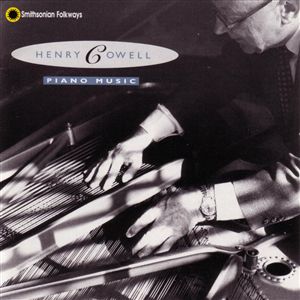
String piano is a term coined by American composer-theorist Henry Cowell (1897–1965) to collectively describe pianistic extended techniques in which sound is produced by direct manipulation of the strings, instead of or in addition to striking the piano's keys. Pioneered by Cowell in the 1920s, such techniques are now often called upon in the works of avant-garde classical music composers.
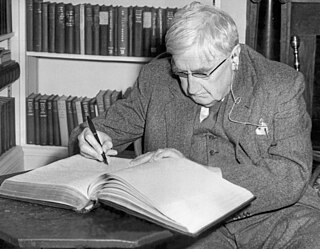
Ralph Vaughan Williams's Symphony No. 8 in D minor was composed between 1953 and 1955. Sir John Barbirolli, its dedicatee, conducted the Hallé Orchestra in the premiere at the Kings Hall in Manchester, on 2 May 1956. It is the shortest of the composer's nine symphonies, and is mostly buoyant and optimistic in tone.

Graham Newcater is a South African composer known for his use of serialism and the twelve-tone technique. His music draws heavily from European modernist traditions, making him a significant figure in South African classical music. While he employed twelve-tone sets, inspired by composers like Anton Webern, Newcater’s distinctive use of intervals—especially minor seconds and thirds—created a unique sound that set his works apart. Some of his most notable compositions include the ballet Raka, the String Quartet No. 1, and solo piano works. Unlike many of his contemporaries, Newcater abstained from engaging directly with South African cultural or musical identity, focusing on the abstract possibilities of serialism.
Symphony No. 2, Op. 19 is a three-movement work for orchestra by the American composer Samuel Barber. The 25-minute work was originally written in 1944. The work underwent many revisions and was finally published in 1950. The original manuscript was withdrawn by Barber in 1964. He ordered that G. Schirmer destroy the original manuscript and all scores in their library. The work remained unpublished for many years until 1984 when a set of parts turned up in a warehouse in England. Renewed interest in Barber's work led to a 1990 reprint of the 1950 edition.
The Short Symphony, or Symphony No. 2, is a symphony written by the American composer Aaron Copland from 1931 to 1933. The name derives from the symphony's short length of only 15 minutes. The work is dedicated to Copland's friend, the Mexican composer and conductor Carlos Chávez. The symphony's first movement is in sonata-allegro form, and its slow second movement follows an adapted ternary form. The third movement resembles the sonata-allegro but has indications of cyclic form. The composition contains complex rhythms and polyharmonies, and it incorporates the composer's emerging interest in serialism as well as influences from Mexican music and German cinema. The symphony includes scoring for a heckelphone and a piano while omitting trombones and a percussion section. Copland later arranged the symphony as a sextet.
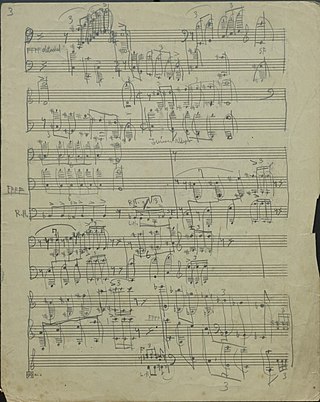
American composer Henry Cowell wrote one of his first surviving piano pieces, Dynamic Motion, in 1916. It is known as one of the first pieces in the history of music to utilize violent tone clusters for the keyboard. It requires the performer to use various limbs to play massive secundal chords, and calls for keys to be held down without sounding to extend its dissonant cluster overtones via sympathetic resonance. Some of the clusters outlined in this piece are those written for fists, palms, and forearms. The piece is also noted for its extended use of tuplets, featuring triplets, quintuplets, and sextuplets in the melody line.
Henry Cowell wrote the piano piece The Snows of Fuji-Yama, HC 395, in 1924.
















